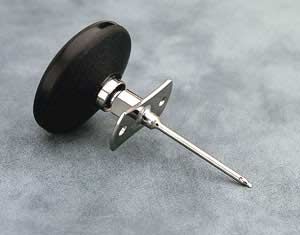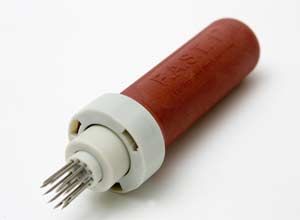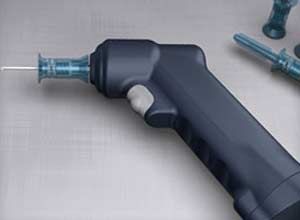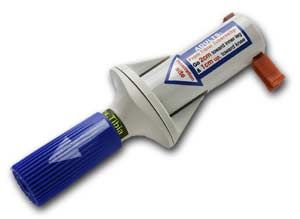By Larry Torrey
The technique of injecting fluids and medicines directly into the bone marrow of the sick and injured has been around since the 1920s. That idea, first perceived as a bit on the barbaric side, was abandoned a short while later with the development of the intravenous cannula. A renewed interest in this technique in the 1980s was credited to an American pediatrician named Orlowski working in the cholera epidemics of India, and an editorial he authored in 1984 (1, 2). Since Dr. Orlowski’s editorial 25 years ago, intraosseous (IO) infusion has become widely acknowledged as a first alternative to difficult intravenous (IV) access (3, 4).
IV therapy in the tactical medical setting offers challenges like very few others. Light discipline, a limited ability to move, patient extrication and evacuation, limited equipment, and the need to get it done quickly and correctly are just some of the obstacles faced by the tactical medic. In this article I will discuss the various IO devices and some of the important aspects of their use in an austere environment.
There are a number of devices, and they fall into two general categories: manual and semi-automatic. The manual devices are the early needles like the Jamshidi™ and the Cook™. These needles literally screw into the bone by twisting it a number of times while applying manual pressure.
|
Jamshidi™ |
 Cook™ |
The devices that are often referred to as semi-automatic are the FAST1™, the EZ-IO™, and Bone Injection Gun™ or B.I.G. They are considered semi-automatic as they are powered in one way or another, with the intent of making insertion quicker and easier and therefore more effective and less painful.
With regard to their effectiveness, allow me to say that they all work. Each of these devices is effective at putting an IO needle tip into the medullary cavity of a bone, the center space where the marrow is located. But, as with most things, there are pros and cons that need to be considered.
In the field, lightweight and reliable equipment is an absolute necessity. If these are your only criteria, then the Jamshidi and Cook IO needles are your best bet. There are no batteries or moving parts to worry about, and they require very little space in your med pack. However, they are not very user-friendly when placing them into a patient, less effective with first-time or infrequent users, and I have to imagine self-application would be very difficult at best (no, I haven’t tried it and I hope to never have to). They take a bit of time to twist and twist until you finally hit your bone marrow target, and they tend to be very uncomfortable going in even with a careful prep of your insertion site with a local anesthetic. My personal recommendation and practice is to carry one, but it resides in the bottom of my bag for use only as a back-up plan.
The semi-automatic devices are far easier to learn and maintain the skill with a short training time (5), and are generally more user-friendly. There are currently three of them on the market in the US.
The FAST1 by Pyng Medical (http://www.pyng.com) is a device used to assist a manual insertion by pushing the needle smoothly and directly into the bone cavity at the correct depth. It is approved for use in the U.S. on patients 12 years and older; there is no pediatric version. It inserts only into the manubrium, the upper portion of the sternum. It is easy to insert and is an effective device, but there are too many small parts to attach after the initial insertion for my personal tastes. I also don’t like the fact that it can only be used on one site, but the trade-off is that I like the sternal site best in terms of delivering medication to vital organs.
 FAST1™ |
The EZ-IO by VidaCare (http://www.vidacare.com) is essentially a battery-powered drill. The drill bits, if you will, are your choice of adult or pediatric IO needles. Both peer-reviewed studies and anecdotal reports give it generally high marks for ease of use and success rates. The approved insertion sites are in either leg at the proximal tibia, just below the knee cap. This device will not offer the sternal access that I prefer, but it does give you outstanding access to the central circulation and a choice of two sites. I think this is important as one site may be damaged, prohibiting its use. For the tactical environment, however, I rate it last in the semi-automatic category simply due to its size, weight, and the need for batteries. If you find yourself working in a stationary medical facility, the EZ-O is certainly worth a second look. If you’re carrying your medical facility around on your back, just keep walking right past this device.
 EZ-IO™ |
The Bone Injection Gun (B.I.G.) by WaisMed Ltd (http://www.waismed.com) is a spring-loaded device that one places over the insertion site and compresses the handle, quickly injecting the needle into the bone. It is approved by the U.S. Food and Drug Administration for insertion only into the upper tibia for both children and adults, the same site as the EZ-IO. But it is also approved and used in other countries for insertion into the wrists, ankles, and the shoulders, allowing for up to eight anatomical site choices. Of the three semi-automatic devices, this is my recommendation for the tactical medic. It’s no more or less effective at getting the job done, but it is far smaller and lighter (3.5 ounces) than the EZ-IO’s bulky 16-plus ounces and doesn’t require batteries, nor does it have the small parts to apply that the FAST1 does, and to me it feels like the time from opening the package to hooking up the fluid is shorter than with the others. This is the IO device that I carry when the need arises.
 Bone Injection Gun™ |
Intraosseous (IO) infusion is a wonderful tool for the tactical medic. It is quick, easy, to learn, and delivers fluids almost immediately to the central circulation (1). It gives you an option when more traditional methods that require more manpower, equipment, and time just won’t do. Choose your device carefully, weighing their strengths against your operational environment and needs.
Disclaimer: I do not receive any remuneration or monetary or material gain of any kind from any of these device manufacturers or their suppliers.
1) http://emedicine.medscape.com/article/80431-overview. Accessed on 9-20-2009.
2) Israeli Journal of Emergency Medicine – Vol. 6, No. 2 May 2006
3) American Heart Association - Circulation 2005; 112-IV, 57-66
4) European Resuscitation Council - European Resuscitation Guidelines; Resuscitation 2005; supp 6751:S47
5) A review of intraosseous vascular access: Current status and military application - Military Med 2000; 165(7):552



